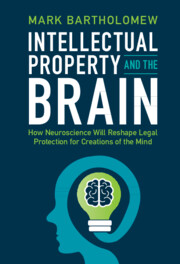 Intellectual Property and the Brain
Intellectual Property and the Brain from Part I - The Law and Neuroscience of Creative Activity
Published online by Cambridge University Press: 14 July 2022
Design patents protect the way a product looks whereas utility patents protect the way a product is used. The law suggests a great disparity between the artistic creation relevant to design patents and the scientific creation relevant to utility patents. The design process is believed to be so personal and subjective that judges refuse to consider any part of a design more important than another. This stands in sharp contrast to the law’s assumptions about scientific invention, which permits objective and focused evaluation of the invention and its prior art. This art/science double standard does not jibe with evidence that the same neural phenomena are at work in all kinds of creative tasks. For scientists as well as designers, both sides of the brain must be engaged in the same process: coming up with an idea, then building on that idea so that it is useful. To earn design patent protection, a claimed design must be “nonobvious” to “the ordinary designer.” To the extent judges refuse to rigorously compare claimed designs against earlier works to determine nonobviousness, they are straying from the way designers actually generate innovative design.
To save this book to your Kindle, first ensure no-reply@cambridge.org is added to your Approved Personal Document E-mail List under your Personal Document Settings on the Manage Your Content and Devices page of your Amazon account. Then enter the ‘name’ part of your Kindle email address below. Find out more about saving to your Kindle.
Note you can select to save to either the @free.kindle.com or @kindle.com variations. ‘@free.kindle.com’ emails are free but can only be saved to your device when it is connected to wi-fi. ‘@kindle.com’ emails can be delivered even when you are not connected to wi-fi, but note that service fees apply.
Find out more about the Kindle Personal Document Service.
To save content items to your account, please confirm that you agree to abide by our usage policies. If this is the first time you use this feature, you will be asked to authorise Cambridge Core to connect with your account. Find out more about saving content to Dropbox.
To save content items to your account, please confirm that you agree to abide by our usage policies. If this is the first time you use this feature, you will be asked to authorise Cambridge Core to connect with your account. Find out more about saving content to Google Drive.